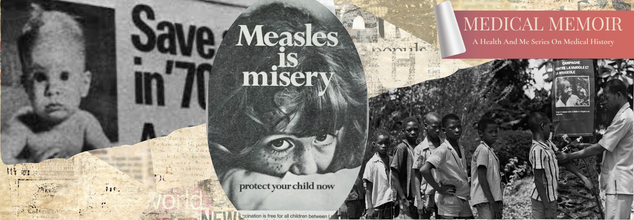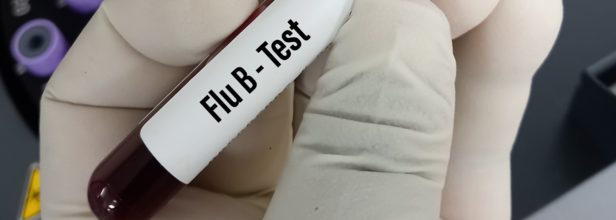- Health Conditions A-Z
- Health & Wellness
- Nutrition
- Fitness
- Health News
- Ayurveda
- Videos
- Medicine A-Z
- Parenting
- Web Stories
Medical Memoir: Measles- The Unfinished Fight Against One Of The World’s Most Contagious Diseases

(Credit-WHO, Science Museum Group Collection)
'Medical Memoir' is a Health & Me series that delves into some of the most intriguing medical histories and unveils how medical innovations have evolved over time. Here, we trace the early stages of all things health, whether a vaccine, a treatment, a pill, or a cure.
Maggie was diagnosed with Leukemia at the age of 2.5-year-old, fighting cancer at a young age, she survived after another two and half years of treatment, but it left her in a very vulnerable state. Her immune system took a big hit, even a common cold could be dangerous for her.
What followed was Maggie’s parents' great efforts to ensure their child gets the best childhood, while making sure she stays safe. But no matter how safe you are or how much you try to keep your loved ones safe, things do not go as planned. Despite their efforts, during a routine visit to her oncologist, Maggie's parents were contacted about a measles case that was known to be in the clinic at the same time Maggie was. Every rash, cold or cough after that seemed like their nightmare come true, however, Maggie was lucky this time because she wasn’t infected.
This is not just a story, but the reality of Dr. Tim Jack, who spoke to the Vaccinate Your Family initiative, urging people not just to vaccinate to take care of their children, but also to ensure the safety of everyone around them. But what significance does this story have for our health? What do we need to be aware of measles?
A household name among diseases, measles, is considered to be one of the world’s most contagious diseases. Causing the deaths of millions, the disease impacts the respiratory tract and then slowly spreads throughout the body. Vaccination was the reason why we were able to control the disease in the 1960s, before which the estimated death each year was said to be 2.6 million death each year, according to the World Health Organization (WHO).
How Old Is Measles?
WHO states that the records of the disease can be traced back to the 9th century by a Persian doctor named Abū Bakr Muhammad Zakariyyā Rāzī. It became more common around the world starting in the 16th century as people traveled more. In 1757, a Scottish doctor named Francis Home discovered that measles was caused by a germ. He showed this by taking blood from sick people and giving the disease to healthy individuals.Places that had never seen the measles virus before were hit very hard. Outbreaks caused a lot of sickness and death in isolated communities, like the Faroe Islands in 1846, Hawai'i in 1848, Fiji in 1875, and Rotuma in 1911.
Also Read: Is Taking Rest Really That Important for Kids? Experts Explain How Much Sleep Shapes a Child’s Brain
Root Cause Of Epidemics And Mass Death
Before vaccines, measles was always present around the world, causing epidemics. In richer countries, better healthcare and nutrition meant fewer people died from measles by the 20th century. While antibiotics couldn't fight the virus itself, they could help with complications like bacterial pneumonia. Still, common problems like ear infections, croup, diarrhea, and pneumonia led to thousands of hospital stays each year. A more serious complication, encephalitis (swelling of the brain), could cause brain damage, loss of hearing or sight, or even death.
Globally, the death rates remained very high, with about 30 million cases and over 2 million deaths every year.
The First Measles Vaccine
In 1954, a measles outbreak at a boarding school near Boston gave doctors a chance to try and find the measles virus. They took samples from sick students. A doctor named Thomas Peebles successfully grew the virus from a sample taken from an 11-year-old boy named David Edmonston. This success allowed doctors to create the very first vaccine against measles.
John Franklin Enders, who was Peebles's boss and is often called "the father of modern vaccines," developed the measles vaccine from a specific strain of the virus called 'Edmonston-B', named after David. This strain is still used today as the basis for most measles vaccines.
Enders and his team tested the vaccine on small groups of children from 1958 to 1960. After that, they started larger trials with thousands of children in New York City and Nigeria. In 1961, the vaccine was declared 100% effective, and the first measles vaccine was approved for public use in 1963.
Global Vaccination Efforts Begin
Starting in the 1960s, individual countries began large-scale vaccination programs against measles. The first international measles vaccination efforts began in Africa in 1966. The World Health Organization (WHO) worked with governments in over 20 newly independent African countries, along with other organizations, to give vaccinations. Their goal was to control measles and also get rid of smallpox.
Despite challenges, like keeping the heat-sensitive vaccine cold during transport and storage, these campaigns showed that vaccination worked against measles. By May 1967, The Gambia became the first country where the measles virus stopped spreading.
In 1968, Dr. Maurice Hilleman, a key figure in vaccine development, created an improved measles vaccine. He weakened the virus by passing it through chick embryo cells 40 times. This resulted in a vaccine that caused fewer severe side effects. This weaker version, known as the Edmonston-Enders strain, led to some of the strains still used in measles vaccines today.
In 1971, Hilleman combined the recently developed vaccines for measles, mumps, and rubella into a single shot called the MMR vaccine. In 2005, the chickenpox (varicella) vaccine was added to create the MMRV vaccine. Standalone measles vaccines are still available in many countries.
Worldwide Vaccination and Challenges
In 1974, measles was one of the first diseases targeted by the WHO when they started a program to expand vaccination efforts globally. Widespread childhood vaccination has dramatically reduced measles cases worldwide. WHO now suggests vaccinating babies at 9 months in areas where measles is common, and at 12–15 months in other areas. A second dose is recommended for all children, which is very important because about 15% of children don't get full protection from just one dose.
Why High Vaccination Rates are Crucial?
Because measles spreads so easily, a very high percentage of people need to be immune (at least 95%) to prevent large outbreaks. If vaccination rates drop too low, outbreaks can happen again when the disease is brought back into a community.
Besides the suffering measles causes, controlling outbreaks is expensive and takes resources away from other healthcare services. Measles deaths still occur in many countries, especially where vaccination programs have gaps. For example, in the Democratic Republic of the Congo, 7,800 people died from measles during an outbreak between 2018 and 2020, compared to 2,299 deaths from Ebola in the same period.
Eradication Efforts and Setbacks
The Americas region was declared free of endemic measles in 2016—the first WHO region to achieve this. However, this status was lost two years later due to a measles outbreak. This outbreak started because of a crisis in one country that led to gaps in vaccination and slow response. The virus then spread to neighboring countries, where it was eventually controlled.
To address these issues, the Pan American Health Organization (PAHO) has been training countries on how to quickly respond to prevent measles and rubella from spreading, improving disease tracking, and launching new, high-quality follow-up vaccination campaigns.
Between 2000 and 2023, measles vaccination prevented over 60 million deaths worldwide. However, despite having a safe and affordable vaccine, global measles deaths continued to rise before the COVID-19 pandemic. In 2019, there were over 207,000 measles deaths globally, which was the highest number of reported cases in 23 years.
Is Measles Still A Cause Of Concern?
According to Harvard Health as of July 2025, there have been 1,288 confirmed measles cases across 38 states in the US, primarily among children. This is the highest number of cases since 2000, the year measles was declared eliminated in the country.
This rise in cases is mainly because fewer people are getting vaccinated. Across the country, measles vaccination rates for school kids dropped from 95% in 2019 to 92% in 2023. In some areas where outbreaks are happening, like parts of west Texas, the vaccination rate is as low as 82%. This leaves many people unprotected. A big reason for the current cases is that 96% of recent infections were in people who weren't vaccinated or hadn't completed their shots.
As the history shows, measles outbreaks can be stopped. The MMR vaccine (Measles, Mumps, Rubella) is very effective, with two doses providing 97% protection, and it's very safe. Side effects are usually mild, like a sore arm or low fever. The false idea that vaccines cause autism has been proven wrong, but this misinformation has made some people hesitant to get vaccinated.
As a responsible citizen, one must ensure they keep in touch with healthcare professionals and keep the safety of their loved ones as well as everybody else around them.
Family Urges Flu Vaccination After 8-Year-Old's Near-Fatal Influenza B Fight

Credits: Canva
Millie Campbell was just eight years old in 2019 when a missed flu shot turned into a life-threatening ordeal, notes ABC News, Australia. What began with aches in her legs soon escalated into multiple organ failure caused by influenza B, a virus her parents never imagined could be so severe.
“They had to drain 200 millilitres of fluid from her heart, it was struggling,” her mother Stephanie Campbell recalled. “I think the doctor's words were: ‘Your daughter could die tonight’.”
Millie was airlifted from Newcastle to Westmead Children’s Hospital in Sydney, reports ABC News. Soon after arriving, she went into cardiac arrest. Her father, Ian Campbell, described the scene as surreal. “There was no indication she was going to survive,” he said.
A Long Road to Recovery
Millie, previously fit and healthy with no pre-existing conditions, spent weeks in intensive care and six months in hospital. The damage from being on life support for so long led to poor circulation, and eventually, doctors had to amputate her left foot.
She had to learn to walk again. Today, reports ABC News, Millie uses a prosthetic leg and has turned to swimming not just for rehabilitation, but as a passion, one that has taken her to national championships and World Trials. Her eyes are now set on the 2028 Paralympics in Los Angeles.
“Millie’s recovery will be a lifelong journey,” Ms Campbell said. “Seeing how severe the flu can be, our message is: talk to your medical practitioner about the vaccine.”
Why Influenza B Is Hitting Children Hard
Although influenza A typically gets more public attention due to its pandemic potential, Australia has seen a sharp rise in influenza B cases, especially in children aged 5 to 16. According to Professor Patrick Reading from the World Health Organization (WHO) Collaborating Centre for Influenza Research, type B can often be more severe in children, though the reason remains unclear.
“It's a bit of a mystery,” Professor Reading told ABC News. “We see this association, but we can't say there's something specific about the virus that causes it to affect children more.”
Vaccination rates among this age group are currently the lowest of all, following a steady decline since the COVID-19 pandemic. Professor Reading warned that fading immunity, combined with lower vaccine uptake, is placing a burden on the healthcare system.
“We're not through the worst of it yet. Flu circulation continues through August to October,” he added. “It’s not too late to get vaccinated.”
Confusion Around Flu Vaccine Access
Millie’s parents said they’d always kept up with her vaccinations. But once she turned five, they mistakenly believed the flu wasn’t a major risk anymore.
Under the National Immunisation Program (NIP), the flu vaccine is free only for children aged six months to five years, people over 65, and other vulnerable groups.
In contrast, states like Queensland and Western Australia are temporarily offering free vaccines to all residents, a move public health experts say should be adopted nationally.
Julie Leask, a vaccination policy expert from the University of Sydney, told ABC News, the current risk-based model isn't working. “When a vaccine is on the NIP, it sends a strong message that it's important,” she said. “Some doctors still wrongly advise against it for kids.”
Misinformation and Vaccine Hesitancy
Falling childhood vaccination rates, rising anti-vaccine sentiment, and misinformation, especially on social media, have complicated public health efforts.
Professor Leask pointed to anti-vaccine rhetoric, such as that from US politician Robert F. Kennedy Jr., as a growing influence in Australia. Kennedy has falsely linked vaccines to autism and recently pushed against COVID-19 vaccinations for children and pregnant women.
“We’re seeing the mainstreaming of misinformation,” Leask warned. “It’s having a ripple effect here too.”
Research shows common reasons parents skip the flu shot for kids include a lack of awareness, absence of a healthcare provider recommendation, time constraints, cost, and safety concerns.
A Family’s Call to Action
As Millie thrives in her new life, her parents remain vocal about the importance of vaccination.
“This growing hesitancy is driven by people struggling to tell the difference between facts and misinformation,” Mr Campbell said. “Most people spend more time on social media than listening to experts, but that’s not where you should be getting your health advice.”
“Vaccination protects not just your child but the whole community.”
The Hidden Turmoil: Why Our Youth Are Quietly Crumbling and What We Can Do About It

In an age of endless scrolling, instant likes, and constant comparison, the mental health of young people is taking a nosedive and fast. The rise in depression, anxiety, self-harm, suicide, and behavioural disorders has exploded in recent years, especially in the wake of the COVID-19 pandemic. Yet, the real tragedy is often hidden behind filtered selfies and people who aren't paying attention.
Quoting the World Health Organisation, Dr. Monica Sood shares that one in seven adolescents between the ages of 10 and 19 globally suffers from a mental health problem. Suicide is the fourth most common cause of death among teens. In India, the numbers are no less harrowing—“a student kills themselves every hour,” says the National Crime Records Bureau.
This is a generation supposedly poised to “have it all”, but as Dr. Sood says, they’re instead buckling under immense pressure, from academic demands and the need for social validation to competition with peers, family expectations, and uncertainty about the future.
While awareness is slowly improving, Dr. Sood laments that “conversations about youth mental health are still clouded by stigma, cultural denial, and a lack of resources.” Therapy remains a luxury, school counselling is scarce, and what should be called burnout has been normalised as digital fatigue.
The Root Causes Go Beyond Exams
Dr. Sood argues that to truly address the crisis, we need to dig deeper. “We need to realise that the crisis is more than just schoolwork or screen time.” Instead, it’s the result of a complicated mesh of factors:
- Unrealistic expectations from society: The pressure to be perfect in every way is, in Dr. Sood’s words, “a psychological war zone.”
- Dysfunctional families: Emotional unavailability, abuse, neglect, and overcontrol can deeply harm a child’s sense of self.
- Lack of emotional vocabulary: Many young people don’t have the words to express what they’re feeling. Instead, their pain shows up as anger, withdrawal, or substance abuse.
- Unfiltered digital exposure: Curated lives on social media fuel jealousy, insecurity, and body image issues.
- Loss of spiritual and community ties: “The feeling of being part of something bigger is fading,” warns Dr. Sood.
A Mental Health Renaissance
But all is not lost. Dr. Sood lays out a refreshingly bold and unconventional action plan for what she calls a mental health renaissance—one that starts in schools and ends in society-wide reform.
Mindfulness and Emotional Literacy in the Curriculum
Dr. Sood urges schools to teach children how to manage their emotions just as they teach math. Weekly lessons in emotional intelligence, stress management, and nonviolent communication should begin from Class 1. “Add art therapy, journaling, breathing exercises, and storytelling,” she suggests, to make these lessons stick.
Empathy Ambassadors in Every Institution
Dr. Sood calls for a peer-led model of support—“Every school, college, and university should choose and train a few older students or peers to be ‘Empathy Ambassadors’.” These students should be trained to listen, maintain confidentiality, and support others in crisis. Sometimes, peer support can be more approachable than formal therapy.
Digital Detox Sabbaticals
“We fast for our bodies; we should fast for our minds too,” Dr. Sood says. She recommends monthly ‘silent days’ in schools and families—no screens, no judgements, just fun, creativity, and nature.
Rebuilding Sacred Third Spaces
Beyond home and school, young people need judgement-free zones to simply exist. “Think of libraries, community centres, and parks as ‘mental sanctuaries’,” says Dr. Sood. These could host music corners, open mic nights, and wellness cafés.
Combining AI, Ayurveda, and Psychology
Dr. Sood’s final suggestion marries ancient Indian wisdom with modern science—“Use Ayurvedic mind-body typing, psychometric tests, and AI-based behavioural tracking to make personalised mental health plans.” She envisions a future where technology aids rather than overwhelms, offering tailored, holistic mental health solutions.
The Body’s Own Fabric Turns Fatal: What You Need to Know About Sarcomas

When we talk about cancer, breast, lung, and colon usually dominate the conversation. But lurking quietly in the background is a lesser-known, often overlooked type: sarcomas. These rare cancers, which take root in connective tissues, don’t always get the attention they deserve. Yet, they deserve it and how.
Not Just One, But Many Types
Sarcomas are a group of cancers which arise from body tissues. It can be from bone, fat, muscle, tendons, nerves, blood and lymph vessels are the predominant ones.
Unlike most other cancers that generally strike older adults, sarcomas don’t discriminate by age. “These cancers can occur in relatively younger age groups,” Dr. Karthik K S, Consultant, Surgical Oncology at KMC Hospital, Mangalore, says. Sometimes, these are also triggered by certain genetic mutations, making them all the more complex.
The Trouble with Tumours
These tumours can quietly grow in any part of the body, which means the symptoms are often subtle and deceptive. Dr. Karthik says, “Presentations may be much simpler than the consequences. Unplanned treatment may lead to rather grievous consequences.”
Because of the wide-ranging locations where sarcomas can appear, they often call for specialists across disciplines. “The treatment of these types of cancers will need specialised doctors, often oncologist surgeons, medical and radiation oncologists,” he explains. In short, a generalist approach just won’t do.
Diagnosis: More Than Just a Scan
Before treatment even begins, the real detective work starts. “The patient will need a full evaluation,” says Dr. Karthik. That begins with imaging, but even this depends on where the sarcoma has taken hold. Once imaging has painted a picture, a biopsy is essential. “These diseases need a biopsy to prove the diagnosis and often subclassify the disease based on IHC (immunohistochemistry),” he says.
If there’s a suspicion of hereditary involvement, genetic studies may also be required. Only once everything is on the table—stage, type, and location—can doctors chalk out a treatment plan.
Surgery Takes the Lead
According to Dr. Karthik, “treatment includes surgery as a main modality of treatment.” But it’s rarely a one-man show. “Treatment may also include chemotherapy and radiotherapy,” he adds, making it a team effort from start to finish.
Kids Are Not Spared
Dr. Sachin Sekhar Biswal, Medical Oncology Consultant at Manipal Hospital, Bhubaneshwar, draws attention to another critical aspect: age is no protection. “Connective tissue is an important constituent of the human body. The cancer that arises from the connective tissue mostly constitutes sarcoma. It can be seen in all age groups, starting from infancy to geriatric populations.”
In fact, in children, sarcomas are surprisingly common. “Rhabdomyosarcoma is the most common type of cancer in the children,” Dr. Biswal states. “Apart from that, osteosarcoma and Ewing's sarcoma are also common types of sarcomas in children.”
Symptoms
Since sarcomas can develop anywhere in the body, the symptoms can be vague or misleading. Dr. Biswal points out, “It can present as a progressively increasing swelling or a lump, bone overgrowth with pain, swelling or limitation in the range of motion, or simply a vague lump based on its location.”
Which is why early detection is tough and treatment becomes even more time-sensitive.
Teamwork Makes the Treatment Work
Dr. Biswal explains that sarcoma treatment is not a one-specialist show. “Sarcoma treatment is always a multimodality effort involving medical and surgical oncologists, orthopaedic oncologists, radiation oncologists, interventional radiologists, onco-pathologists and the rehabilitation team.”
He shares that the most common treatment plan includes “surgical excision followed by radiation or chemotherapy”. When it comes to bone or limb sarcomas, gone are the days when amputation was the only solution. “Limb salvage therapy rather than amputation is the new way. It can be achieved by high-quality implants or autografts,” he adds.
Speed Is Everything
Time really is of the essence. Dr. Biswal stresses, “Though rare, the tendency to metastasise is high, such that diseases like Ewing’s sarcoma are considered systemic from the very time of diagnosis.” In other words, even at diagnosis, it’s already a whole-body concern.
But with timely diagnosis and swift treatment, outcomes can be significantly improved. “A timely diagnosis and a prompt treatment can save a life and avoid much morbidity,” Dr. Biswal reminds us.
© 2024 Bennett, Coleman & Company Limited

